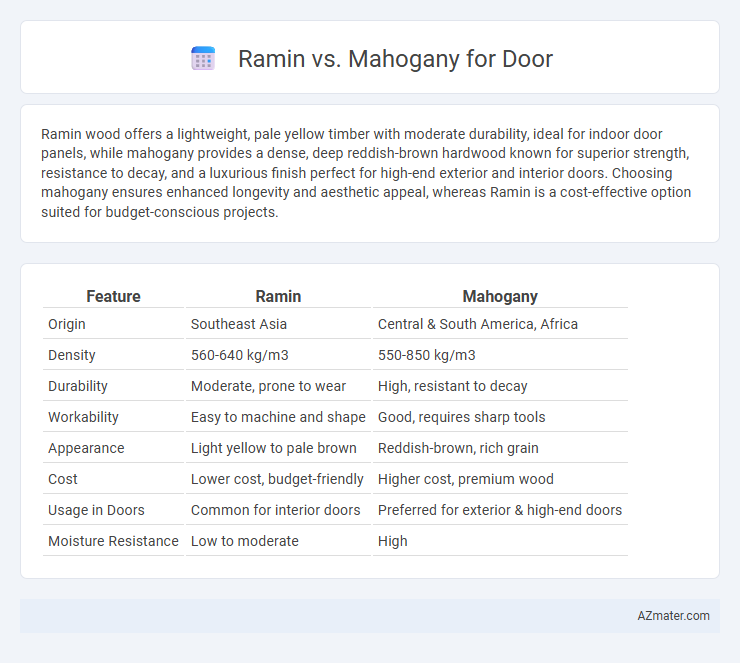Ramin wood offers a lightweight, pale yellow timber with moderate durability, ideal for indoor door panels, while mahogany provides a dense, deep reddish-brown hardwood known for superior strength, resistance to decay, and a luxurious finish perfect for high-end exterior and interior doors. Choosing mahogany ensures enhanced longevity and aesthetic appeal, whereas Ramin is a cost-effective option suited for budget-conscious projects.
Table of Comparison
| Feature | Ramin | Mahogany |
|---|---|---|
| Origin | Southeast Asia | Central & South America, Africa |
| Density | 560-640 kg/m3 | 550-850 kg/m3 |
| Durability | Moderate, prone to wear | High, resistant to decay |
| Workability | Easy to machine and shape | Good, requires sharp tools |
| Appearance | Light yellow to pale brown | Reddish-brown, rich grain |
| Cost | Lower cost, budget-friendly | Higher cost, premium wood |
| Usage in Doors | Common for interior doors | Preferred for exterior & high-end doors |
| Moisture Resistance | Low to moderate | High |
Introduction to Ramin and Mahogany Wood
Ramin wood, derived from Southeast Asian species in the genus Gonystylus, is known for its fine texture, light color, and durability, making it an excellent choice for door construction. Mahogany, sourced mainly from the Swietenia genus, features a rich reddish-brown hue, exceptional hardness, and resistance to rot, often preferred for high-end doors. Both woods offer unique aesthetic and structural properties, with Ramin being lighter and more affordable, while Mahogany provides superior strength and a prestigious appearance.
Physical Characteristics Comparison
Ramin wood is lighter in color with a fine, uniform texture and straight grain, offering moderate hardness and excellent workability for door applications. Mahogany displays a rich reddish-brown hue with a smooth, interlocked grain pattern, known for its high durability and resistance to moisture and decay, making it ideal for premium doors. Both woods provide stability, but Mahogany typically delivers superior strength and longevity, while Ramin is favored for lightweight and cost-effective door construction.
Durability and Strength Analysis
Ramin wood offers moderate durability with a Janka hardness of approximately 1,290 lbs, making it suitable for indoor doors but less resistant to heavy impact or outdoor conditions. Mahogany, particularly genuine African or Honduran variants, boasts superior strength and durability, featuring a Janka hardness around 900-1,070 lbs paired with excellent decay resistance and dimensional stability. For doors requiring long-lasting performance and resistance to wear, mahogany is generally the preferred choice due to its robust fiber structure and natural resistance to moisture and pests.
Resistance to Weather and Pests
Ramin wood exhibits moderate resistance to weather but is less durable against pests compared to mahogany, which offers superior natural resistance to both moisture and insect attacks. Mahogany's dense grain and natural oils make it an excellent choice for exterior doors exposed to harsh weather conditions and termite-prone areas. While Ramin can be treated to improve durability, mahogany inherently provides greater longevity and stability in outdoor applications.
Appearance and Grain Differences
Ramin wood features a pale yellowish to light brown color with a relatively straight and fine grain, giving doors a smooth and uniform appearance. Mahogany doors stand out due to their rich reddish-brown hue and prominent, interlocking grain patterns that provide a more luxurious and visually striking finish. The subtle and consistent grain of Ramin contrasts sharply with Mahogany's bold, swirling grains, making each wood ideal for different aesthetic preferences in door design.
Cost and Availability Comparison
Ramin wood is generally more affordable than mahogany due to its faster growth rate and wider availability, making it a cost-effective option for door construction. Mahogany, renowned for its rich color and durability, commands a higher price and is less readily available because of slower growth and limited regional supply. Both woods offer quality door materials, but Ramin's accessibility and lower cost make it preferred for budget-conscious projects.
Ease of Workability and Installation
Ramin wood offers superior ease of workability compared to mahogany due to its softer texture and consistent grain, allowing for smoother cutting, shaping, and finishing. Mahogany, while durable and dense, can be more challenging to work with during installation because it requires sharper tools and more effort to achieve precision. This makes ramin a preferred choice for efficient door installation and detailed woodwork.
Environmental Impact and Sustainability
Ramin wood, sourced primarily from Southeast Asian rainforests, faces sustainability challenges due to overharvesting and stringent regulations under CITES, leading to concerns about habitat loss and restricted availability. Mahogany, especially from responsibly managed plantations or FSC-certified sources, offers a more sustainable option with better environmental stewardship and a slower rate of deforestation impact. Choosing FSC-certified mahogany ensures reduced carbon footprint and supports conservation efforts, while ramin requires careful sourcing verification to mitigate ecological harm.
Popular Applications in Door Manufacturing
Ramin wood is favored in door manufacturing for its smooth texture, light color, and ease of finishing, making it ideal for interior doors and decorative panels. Mahogany is widely popular for exterior doors due to its durability, resistance to rot, and rich, reddish-brown hue that offers a premium aesthetic. Both woods are commonly used in solid core door construction, with Ramin preferred for cost-effective, lightweight options and Mahogany for high-end, long-lasting doors requiring superior weather resistance.
Which Wood Is Better for Doors?
Ramin and Mahogany are both popular choices for door construction, with Mahogany often favored due to its superior durability, natural resistance to decay, and rich, reddish-brown color that enhances aesthetic appeal. Ramin, being lighter and less dense, is more affordable but lacks the long-term strength and weather resistance of Mahogany, making it better suited for interior doors rather than exterior applications. For doors requiring high performance, especially in outdoor settings, Mahogany's stability and resistance to moisture make it the better wood choice.

Infographic: Ramin vs Mahogany for Door
 azmater.com
azmater.com